It goes without saying that whether a fish is beautiful or not, it first needs to be friendly to others in order to qualify as a good addition for a crowded fish tank.

So is there a large and peaceful community fish that would best fit your freshwater aquarium as its centerpiece species?
What are some good small fish that would enjoy living in such communities?
Also, what are the big yet friendly fish that will tolerate the smaller ones dashing under their nose?
With fish, there’s an unwritten rule that whatever fits in their mouth is food.
Schooling fish are the types that are generally agreeable to other aquatic species since all they really want to do is to school together.
The following list will guide you in deciding which pet fish will suit the biotope you’d like to keep. For example, you’ll learn what tropical aquarium fish will form the best and most social community in an aquarium.
Let’s now find answers to all these (and more) questions.
Group behavior in freshwater aquarium fish is a function of both social connectivity and a mechanism for increased chances of survival. By being smart when combining species you can achieve a beautiful and safe environment in the fish tank.
Have a look at the 24 best community fish for a home aquarium:
1. Roseline Torpedo Shark – Sahyadria denisonii
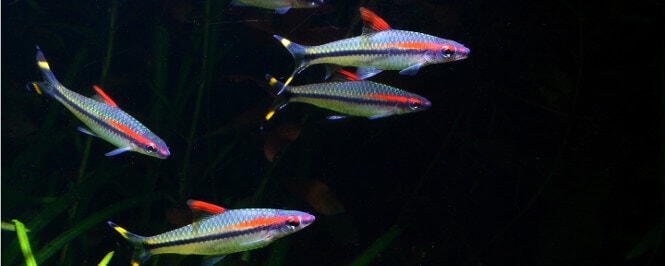
By Anandarajkumar
| Compatible With: | Zebra danios (more than 7), Siamese algae eaters, Tiger barbs (more than 6), Black skirt tetras (a school of at least 6), and cichlids such as the Bolivian Ram (fast-swimming). |
| Size: | 5 to 6 inches or between 12.7 to 15.2 cm |
| Suggested Water Temperature: | 72°F to 77° (22.2°C to 25°C) |
| Suggested Tank Size: | 75+ gallons |
This freshwater fish from the small Sahyadria genus is known as Red-line torpedo Barb.
It has a red pigmentation that gets more intense if you keep it in the right environment and with a proper diet.
Because of their shark-like appearance, people tend to include schools of this fish species in their shark-themed tanks. Click here to learn more about freshwater aquarium sharks.
Due to its attractive beauty and personality, from the moment it was discovered it has been hunted down to near-extinction in the wild, so it is currently classified as an endangered species.
To meet the skyrocketing demand, many of the fish stores now raise it in tanks since the wild-caught types are hard to come by.
If you’d like to see a rare beauty in your freshwater community tank, try this fish.
The Roseline Torpedo Shark originates from India (as its scientific name hints) in a habitat whose waters are highly oxygenated and you’d need to replicate that in your freshwater aquarium if you are to make this fish feel at home.
It will also not tolerate dirty aquarium water.
The Roseline Torpedo Shark is one of the best schooling fish for a community tank because it is peaceful and friendly to other tank-mates. As a schooling fish, it spends its good moments swarming with its companions, instead of harassing other tank-mates.
If you keep too few, the Roseline Torpedo Sharks become aggressive or stressed.
This fish is harmless to aquatic plants, making it a perfect addition to a planted tank.
I recommend the following aquarium gear for a school of Roseline Torpedo Sharks:
- Lights: I recommend The Current USA Satellite Plus PRO lights as they will keep the aquatic plants in the 75-gallon tank thriving. You can compare deals for these aquarium lights by checking them out at Amazon and at Chewy.
- Filter: Since a filter should turn the water in the aquarium at least 5 times per hour I recommend getting an Aqueon QuietFlow 400. It’s a canister filter that provides 400 GPH (gallons per hour) of flow rate.
It will keep the 6 Roseline Sharks in your 75-gallon tank happy.
- Heater: For bigger aquariums such as a 75-gallon one (or larger), I recommend using an Eheim JAGER water heater.
The 300-Watt Jager is easy to set up and keeps the temperature exactly within the range you select. See whether Chewy or Amazon has the best offer for it.
2. Bolivian Ram – Mikrogeophagus altispinosus
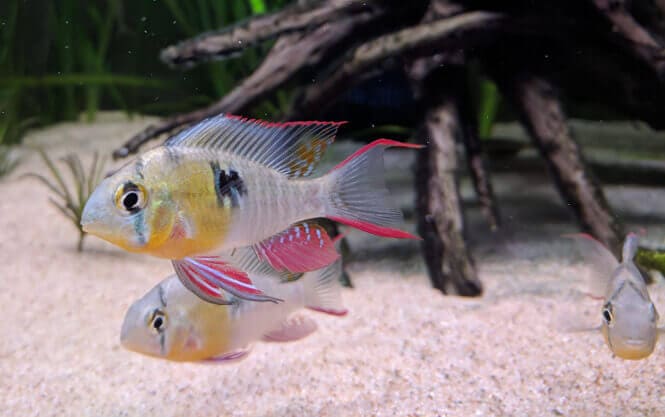
By Johnathanlegoeland
| Compatible With: | Corydoras Catfish, Angelfish, Emperor Tetras, Bristlenose plecos, Dwarf Gouramis, Honey Gourami, a school of Tiger Barbs, and many other equally peaceful fish. |
| Size: | 3 inches or 7.6 centimeters |
| Suggested Water Temperature: | 75°F – 83°F (24°C – 28°C) |
| Suggested Tank Size: | 20+ gallons |
Cichlids are generally aggressive, but the Bolivian Ram is an exception.
Coming from the Mikrogeophagus genus, it’s a freshwater community fish that is peaceful, and mostly content with roaming the fish tank’s bottom or middle section.
Bolivian Rams are not just peaceful but also shy at times — all the traits you need in a community tank fish.
However, make sure that its tank-mates are not too small for the Bolivian Ram to mistake them for food. Since this species feels comfortable in a 20-gallon aquarium, I recommend you check out my article about stocking ideas for that tank size.
Here is why Bolivian Ram can be a good centerpiece fish for a community aquarium:
Bolivian Rams are among the best centerpiece fish for a community tank because their coral red, blue, and silvery blue colors make them stand out from the group. At the same time, the Bolivian Rams are also quite peaceful and will tolerate almost any smaller schooling fish.
The Bolivian Ram is so great that I added it to my list of the most cool-looking freshwater aquarium fish. Bolivian Rams have a unique, and interesting swimming style that involves dashing forth and then pausing immediately before resuming the flight.
It’s an on-off-on-off kind of swimming.
Bolivian Rams are a good fish for a beginner’s freshwater aquarium, being reasonably hardy.
They mainly require only well-aerated water to be happy.
Additionally, Bolivian Rams are omnivores, meaning they eat virtually anything.
A planted tank with caves is also a plus for them and will be appreciated.
I recommend this equipment for a 20-gallon community tank with a Bolivian Ram:
- Lights: The NICREW ClassicLED aquarium lights will support any low-light live plants like the aquatic Java Fern that you end up putting in your community tank. This brand of lighting also brings out the beautiful colors of your fish, which is more than welcome with a colorful Bolivian Ram in the aquarium.
- Heater: Easy to set up and use, The Cobalt Aquatics Neo-Therm Heater won’t fail when it comes to keeping a stable water temperature in your aquarium. See whether its 150-Watt version is on a deal at Amazon.
- Filter: With this canister filter you can make sure that the water in your Bolivian Ram aquarium is kept clear at all time. The Fluval 107 provides a water turnover of about 5 times per hour.
3. Congo Tetra – Phenacogrammus interruptus
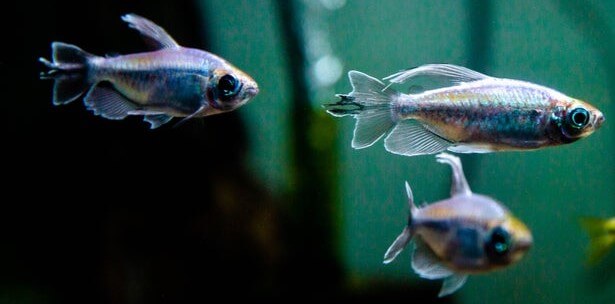
By Zanson8
| Compatible With: | Other Tetras or similarly peaceful, small species. |
| Size: | up to 3 inches for the larger males (7.6 cm) |
| Suggested Water Temperature: | 74 to 80°F (23.3 to 26.6°C) |
| Suggested Tank Size: | Not less than 30 gallons |
Of course, Congo tetras originated from Congo.
These fish are part of а genus known as Phenacogrammus.
They are peaceful schooling fish and their colorful patterns can greatly contribute to an entertaining aquarium environment.
Here is why Congo tetras are considered a good tropical community fish:
Congo tetras are the best freshwater community fish for schooling in larger tropical aquariums because each is relatively big in size, and they should be in a group of at least 6 companions to be comfortable. Their size and schooling behavior makes them a great addition to a spacious community aquarium.
To give them more comfort and happiness, provide your Congo tetras with bright aquarium lights.
It also helps if they are the majority in the tank.
I have also noticed that they feel at home as soon as you introduce them into the fish tank, provided there are many of them.
Congo tetras are very beautiful, having all the rainbow colors but with a glowing orange standing out.
In fact, it is arguably the most beautiful in the tetras family.
I personally like their flowing fins.
These tropical community fish are omnivorous, and one trait I better point is that they eat a lot.
This will ensure no leftover foods are rotting in your fish tank, so take it positively. Naturally, you should not overfeed Congo tetras as this can eventually lead to high Nitrate in the freshwater aquarium’s water.
Anyway, they like tiny foods like vegetables, daphnia, live insect larvae, or micro pellets.
I recommend using the following aquarium equipment for a school of Congo Tetra fish:
- Lights: Bright enough for a heavily planted tank, the BeamsWork DA FSPEC Pent will be a great addition for a 30-gallon community aquarium with Congo tetras.
- Heater: Coming with a shatterproof design, I really like the Cobalt Aquatics Neo-Therm heater as it also manages to maintain the ideal aquarium temperature that I preset.
For a 30-gallon tank use the 150-Watt one. You can find the heater online – Amazon has it.
- PH buffering: Those Almond Leaves are great at naturally keeping lower PH in the aquarium. Congo Tetras should be kept at 6 to 6.5 PH.
- Filter: With a canister filter such as the Penn Plax Cascade 700 you will keep a decently-stocked 30-gallon aquarium with Congo Tetras free of debris.
The filter’s rated for up to 65-gallon aquariums and will turn the water over in your 30-gallon one around 6 times per hour (which is ideal). Check the Cascade 700 at Chewy here or click here to see it on Amazon.
4. Harlequin Rasbora – Trigonostigma heteromorpha
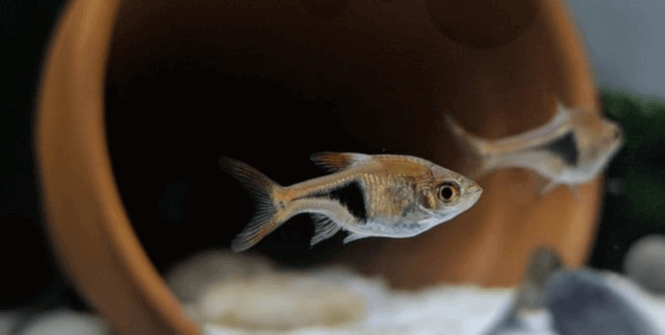
By PhilTheGouramiAndCo
| Compatible With: | snails, shrimps, Guppies, Platies and other calm fish. |
| Size: | 2 inches (5 cm) |
| Suggested Water Temperature: | 70.7 to 84.2°F (21.5 to 29°C) |
| Suggested Tank Size: | 10 gallons can do, but 20 gallons would be more comfortable for them |
The Harlequin rasbora is one of the smaller tropical community fish for a freshwater aquarium that a beginner should start with.
This friendly fish is a member of the Trigonostigma genus, which is native to Southeast Asia.
They are easy to maintain and look after.
However, if they are in a group, they enjoy shoaling in the middle column of the aquarium, showing off their vibrant colors.
They sure brighten up the fish tank with their orange fins.
They trouble no one, as long as they have space for swimming.
For these reasons, many aquarists like them, and so they are always in high demand on the market, and it is hard to find a pet store without them.
They eat both plants and flesh, so you have many options when it comes to their menu.
Insect larvae and detritus are some of the foods you can feed them.
Make sure the bigger fish in the community are not aggressive or keen on eating smaller fish like the Harlequin rasbora.
5. Electric Blue Acara – Andinoacara pulcher
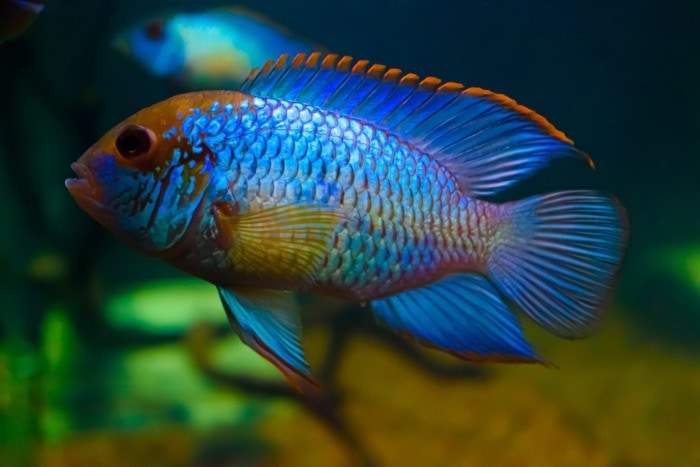
By AH_Childish
| Compatible With: | Corydoras Catfish, Oscars, Congo Tetras, Parrot Cichlids, Black and White Skirt Tetras, Rainbowfish and even Harlequin Rasboras |
| Size: | 6 inches or 15.2 centimeters |
| Suggested Water Temperature: | 72 – 82°F (22.2 – 27.7°C) |
| Suggested Tank Size: | 30-gallon tank at minimum |
The Electric Blue Acara is a rather peaceful cichlid that grows to about 6 inches and tolerates other disciplined community fish in its tank.
In my observations, this fish from the Andinoacara genus, is typically docile and it will not bother any adequately-sized roommates.
The only tank mates at risk would be fish that are simultaneously too small and too slow relative to the Acara.
This fish would never start a fight with an unwilling tank mate that doesn’t fit in its mouth.
Author’s note: Although peaceful, a mating pair of Electric Blue Acara cichlids will establish a territory in the tank and they WILL protect it. For this reason, to avoid possible conflict, I recommend getting a single specimen if you want a bright centerpiece fish.
You could also try getting only males, but mistakes in telling females from males do happen.
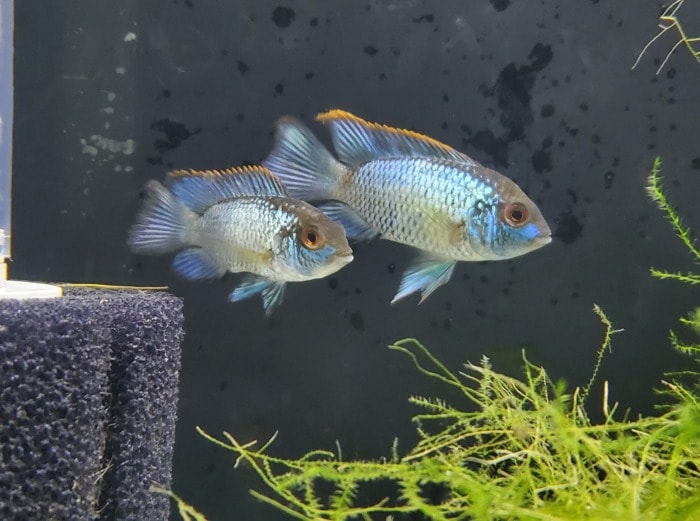
By odenip33
Anyway, all of this makes the Electric Blue Acara a good addition to a larger community tank.
A 40-gallon tank with peaceful fish that are half the size of the Acara is a good example setup.
Anyhow, the EBA cichlid is not a picky eater but it does tend to show more colors when fed high-quality.
Do some research on cichlid foods for better color.
6. Male Endlers – Poecilia wingei
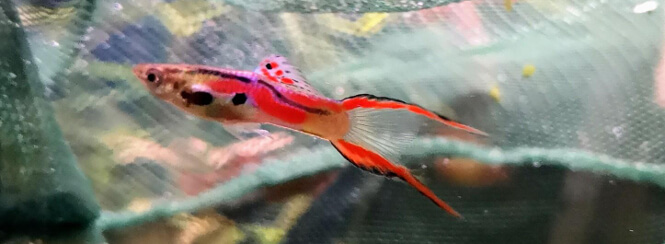
| Compatible With: | White Cloud Minnows for a cold-water tank, Dwarf Corydoras, small Rainbowfish, smaller non-aggressive tetra species, such as Embers, Pristella, and Neon tetras, other peaceful kinds. |
| Size: | 1 inch for the males, 1.8 inches for the females (2.54 cm for males and 4.6 cm for females) |
| Suggested Water Temperature: | 18.3 to 26.6°C (65 to 80°F) |
| Suggested Tank Size: | 10 gallons |
Male Endlers are some of the best and most colorful community fish one should consider for stocking a 10-gallon freshwater tank.
The male Endlers are generally prettier than the females, having vibrant colors that stand out.
They are also smaller and remain small (1 inch) in their adult lives, making them suitable for, say, a small office aquarium.
Endlers are tropical freshwater fish from the widespread Poecilia genus and are easy to care for because they are quite hardy.
As omnivores, they would eat anything that fits into their small mouths.
They do well in planted, warmer fish tanks. If you keep them in cold waters, they will grow slowly.
Endlers are not just peaceful but also agreeable, going out of their way to be nice to other tank-mates that are equally well-natured.
They never fight among themselves like some other fish do.
Endlers seem to never tire from swimming everywhere, inquisitively watching anything they consider unusual.
While they are friendly, they are not timid and would boldly swim through caves, curiously checking what’s inside.
Any noise or sudden water movement invites their attention as if they are the aquarium’s police.
Go for male Endlers if you want to see more movements and less aggression in your community tank.
7. Pearl Gourami – Trichopodus leerii
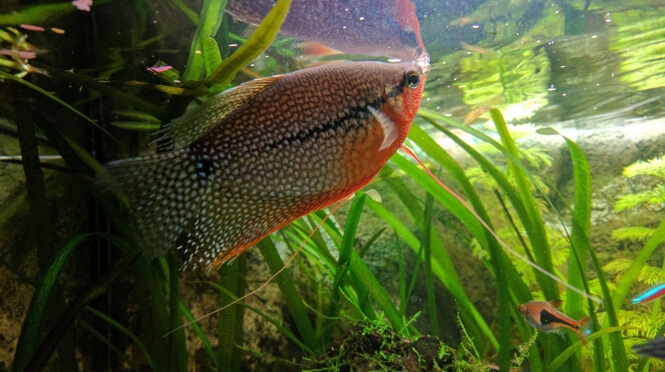
By yackim
| Compatible With: | Platies, Dwarf Cichlids, Swordtails, peaceful bottom-dwellers such as Corydoras and a wide variety of schooling fish. |
| Size: | 4.5 inches (11.5 cm) |
| Suggested Water Temperature: | 76°F – 81°F (24°C – 27°C) |
| Suggested Tank Size: | 20+ gallons |
The Pearl Gourami is a pretty freshwater community fish with a pearly appearance, so its precious name is well-fitting.
Like many of the other popular fish, it has more than one name; it’s also called Mosaic Gourami or Lace Gourami and comes from the Trichopodus genus in the gourami family.
The Pearl Gourami is made more beautiful by a dark line that runs horizontally through its body. It is essentially one of the most brightly-colored freshwater fish that can be seen in home aquariums.
Due to their size, the Pearl Gouramis are among the best big fish for a medium-to-larger community tank with small schooling aquarium mates.
A group of 3 Pearl Gouramis can be a good centerpiece trio for larger community aquariums.
The Pearl Gourami also happens to be one of those exceptional fish that breathe by sucking oxygen directly from the air, a trait that requires them to swim to the water’s surface once in a while.
This is one of the characteristics that make the Pearl Gourami a hardy fish because it can tolerate low-oxygen waters.
A Pearl Gourami will have a tiny, upward mouth that can ‘talk’, thanks to the labyrinth organ through which the fish can make croaking sounds. A planted tank, low lighting, achieved by adding floating plants, not dimming the light, and a dark sandy substrate are some of the aquarium conditions Pearl Gouramis enjoy.
The Pearl Gourami fish eat both plants and meat, so feed them worms, vegetables, etc.
8. Cardinal Tetra – Paracheirodon axelrodi
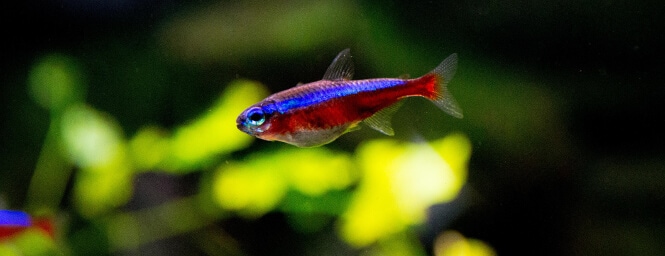
By Muzrub
| Compatible With: | dwarf Gouramis, other schooling tetra species, dwarf cichlids, Loricariids, dwarf Rasboras, Kuhli Loaches, Guppies and others |
| Size: | 2 inches (5 cm) |
| Suggested Water Temperature: | 77 to 87 degrees F (25 to 30.5 degrees C) |
| Suggested Tank Size: | 20 gallons or more |
The Cardinal tetra is another good tropical fish for a freshwater community aquarium because they have vivid coloration and are very active schoolers.
This tetra species is from the Paracheirodon genus.
Many beginners mistakenly buy Neon Tetras believing they’re Cardinal tetras.
And I can’t blame them, because these species look similar from a casual glance.
They both have a red stripe that runs on their bodies horizontally, but the difference is that while the stripe covers only half of a Neon Tetra’s body, the same goes all the way down in a Cardinal tetra.
And here is why Cardinal tetras are best kept in a planted community fish tank:
Cardinal tetras are the best small community fish for a heavily planted fish tank with softer water because of their origin. They originate from areas with dense aquatic vegetation and therefore thrive in a replica of the same in their captivity. They are also peaceful and like to school around, giving a good contrast to a green background of live aquatic plants.
They have no time to harass other community tank mates.
In their natural habitat, one school can contain more than a hundred of them.
This may not be practical to replicate in your home fish tank, but you can keep at least half a dozen.
This, however, doesn’t mean you can’t do with 5 specimens or less, though in such a scenario they may show signs of stress and timidity.
The reason beginners go for Cardinal Tetras is that these fish are easy to keep once acclimated to the aquarium.
Once you provide them with favorable water conditions and shaded areas in the fish tank where the water is less turbulent, the rest will be the usual basics.
Cardinal tetras enjoy small-sized portions of food such as tubifex, flake food, daphnia, and micro pellets food.
They are compatible with all peaceful aquarium tank mates of the same size.
9. Pygmy Hatchetfish – Carnegiella myersi
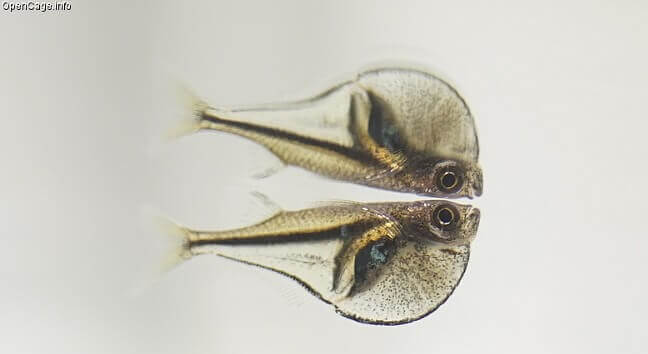
By OpenCage
| Compatible With: | Dwarf Corydoras, dwarf Rasboras, Dwarf Cichlids, and Loaches, small tetras and livebearers |
| Size: | 1 inch or 2.54 cm |
| Suggested Water Temperature: | 74.3 to 79.7°F (23.5 to 26.5°C) |
| Suggested Tank Size: | 10 gallons |
The Pygmy Hatchetfish is yet another fish suitable for a community aquarium, that remains small even as an adult.
These fish from the Carnegiella genus, are native to the Amazon and Orinoco river basins in South America.
You can have several of them in a fish tank without losing much space.
Pygmy Hatchetfish are probably the best top-dwelling nano fish for a peaceful community tank because, in their natural habitat, the waters are shallow. They grow no more than 1 inch and avoid conflicts among themselves and with their tank-mates.
The Pygmy Hatchetfish are usually near the top of the water surface, jumping up with the aid of their strong pectoral fins.
You should provide them with ample surface area to accommodate their shoaling.
Keep at least six of them if you want to see them shoal more confidently.
A Pygmy Hatchetfish appreciates a quiet environment, so keep the current of your filter away from the tank’s top if possible (a canister filter works best for this).
Add some floating plants to dim the lights since these nano fish are not fans of bright light.
Ensure you mainly provide them the floating type of food.
Being insectivores, they delight in dishes like bloodworms, small dried insects, brine shrimp, etc.
Suggested Aquanswers Read: Best Aquarium Heaters for Small Fish Tanks
10. True Siamese Algae Eater – Crossocheilus oblongus
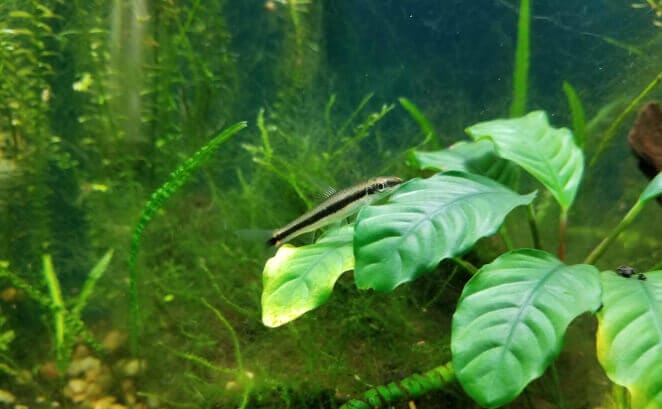
By Irecruitfish
| Compatible With: | Guppies, Tetras, Gouramis, Corydoras, Danios, Angelfish, Barbs (if in a school of 4 or more) |
| Size: | 6 inches (15 centimeters) |
| Suggested Water Temperature: | 76 to 80°F (24.4 to 26.6°C) |
| Suggested Tank Size: | 20 gallons long or larger tanks |
The True Siamese Algae Eater is assigned to the Crossocheilus genus, the members of which are found in Asian fast-flowing rivers with rocky bottoms.
As the very name suggests, Siamese Algae Eaters eat and reduce algae so having them around does more than just fill a community fish tank with peace.
Speaking of peace, they are indeed calm and tend to lead a conflict-free life.
However, Siamese Algae Eaters naturally dislike sharing a space with the red-tailed sharks.
Along with that shark, they also don’t get along well with aggressive species like many cichlids.
When you go to buy one, ensure you get the real one since fake types are being posed to inexperienced fish-keepers. To learn how to differentiate between the false and the true Siamese Algae Eater, along with other care basics for this fish you can click here.
11. True Black Mollies – Poecilia sphenops
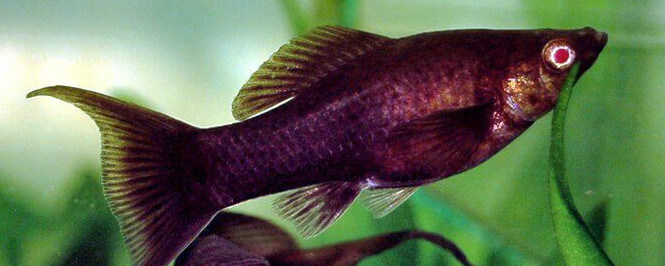
By Marrabbio
| Compatible With: | Angelfish, Danios, Endlers, Swordtails, Guppies Gouramis, female Betta, Tetras, Platies |
| Size: | 5 inches (12.5 centimeters) |
| Suggested Water Temperature: | 75°F to 81°F (23.8°C to 27.2°C) |
| Suggested Tank Size: | 20+ gallons |
The True Black Molly is likely the best algae-eating fish for a freshwater community tank with tropical water temperatures.
Coming from the Poecilia genus, Black Mollies are algae eaters who prefer to graze on hair algae. However, what’s impressive about them is that they even consume black algae.
Anyway, this tropical fish likes swimming around, searching for tender plants to nip on.
While they live peacefully with other tank-mates, at times the males do fight among themselves over females.
Black mollies are livebearers, so breeding them is no big deal, but you better protect their babies from being eaten by other fish who could mistake them for food.
12. Keyhole Cichlid – Cleithracara maroni
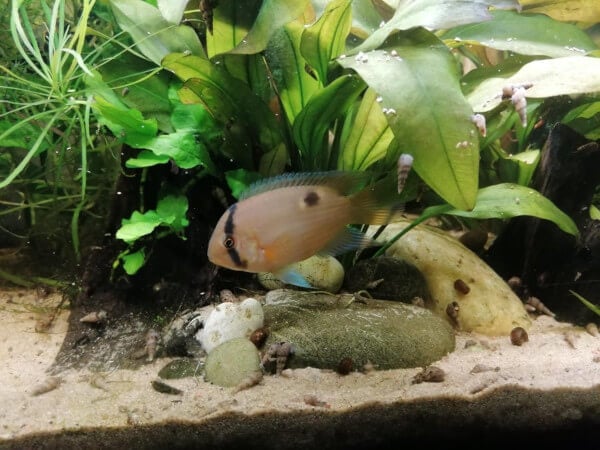
By Djingleberg
| Compatible With: | Rainbow cichlids, smaller schooling Tetras, Corydoras, Pygmy Gouramis, Rainbowfish, Platies, and others |
| Size: | 4 inches (10 cm) |
| Suggested Water Temperature: | between 71.5°F and 80°F (22 to 26.5°С) |
| Suggested Tank Size: | 40 gallons or more |
The only member of the Cleithracara genus, the Keyhole Cichlid has keyhole-like spots near its tail.
Unfortunately, the Keyhole Cichlid is not among the top-selling pet fish because of its odd or unbecoming colors. One trait many fish-keepers overlook is that it is among the very few peaceful and shy cichlids from the small species.
The Keyhole Cichlid is the best large yet peaceful fish species for a community fish tank because of its personality and odd colors that stand out. Therefore, you should consider it as a big centerpiece fish for your freshwater aquarium.
The Keyhole Cichlid is also one of the most intelligent of the cichlids.
Through this intelligence, it has learned the importance of monogamy.
The Keyhole Cichlid couple remains intact even after the spawn of their babies – a phenomenon you rarely see in other cichlid species, or animals for that matter.
Both parents care for their offspring, and the only time they are likely to turn aggressive is when the other preying tank-mates endanger their beloved babies.
Generally, when kept with other calm tank mates you should have no issues with your Keyhole Cichlid.
This is why I recommend these large peaceful cichlids for your community fish tank.
You should also keep them singly or in a pair of male and female.
Anyway, if you want this centerpiece Cichlids for your large aquarium I recommend reading my guide on fish foods that enhance the growth in Cichlids. I’ve compiled some solid advice on Cichlid diets in the guide and I made it as beginner-friendly as possible.
13. Honey Gourami – Trichogaster chuna
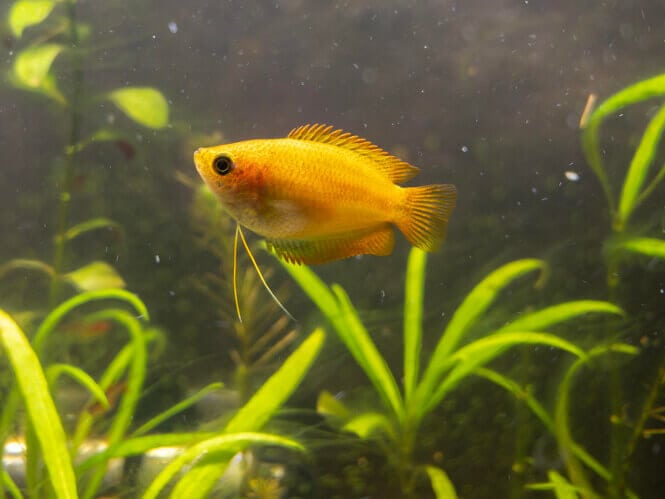
By Eternalcheddar
| Compatible With: | small Plecos, Tetras, Corydoras, Guppies, Gold Gouramis, Blue Gouramis |
| Size: | 3.2 inches (about 8 centimeters) |
| Suggested Water Temperature: | 74-81°F (23.3 – 27.2°С) |
| Suggested Tank Size: | 20 Gallons for a community tank |
It is easy to confuse Dwarf Gourami with the Honey Gourami.
First, they are close cousins from the Trichogaster genus and do share some similarities.
On top of that, some fish stores do not help matters, because they usually add the name “dwarf” even to a Honey Gourami.
Honey Gouramis have eyes that are much closer to their mouths compared to the Dwarf Gourami.
The Honey Gourami can be a fantastic choice for a relatively big centerpiece fish in a community aquarium because it is not aggressive and has a beautiful bright coloration.
It’s also a freshwater fish that is fitted for beginners because it is hardy, effortlessly adapting to different water conditions as long as there are no violent fluctuations in the parameters.
A Honey Gourami also suits nano tanks, being fairly tiny in size.
Being timid, peaceful, and non-aggressive, this fish can form part of your community tank without causing a scene now and then.
Honey Gouramis actually interact with other peaceful fish species in the community.
They enjoy shoaling from the bottom to the top when happy.
However, they like to relax in the middle column or at the top.
Keep Honey Gouramis singly or in a pair of 1 male and 1 female.
14. Peacock Gudgeon – Tateurndina ocellicauda
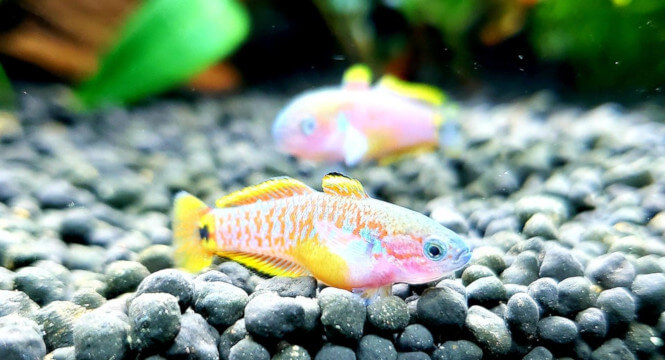
By satansearthworm
| Compatible With: | Honey Gourami, Rice fish, Gertrudae rainbows, Panda cories (keep at around 74 Fahrenheit in this case), Guppies, schooling Tetras and Rasboras |
| Size: | 2.5 inches (6.3 cm) |
| Suggested Water Temperature: | 71 – 80.5°F (21.6 – 25.6°C) |
| Suggested Tank Size: | 15 gallons or more |
Although not so popular yet, the Peacock Gudgeon is a fantastic choice as a colorful fish for social community aquariums.
The Peacock Gudgeon is the only known member of the Tateurndina genus.
It is a beautiful nano fish that is going to stand out in your tropical freshwater aquarium.
These colors offer a splendid display, especially if you keep them in a group.
They are playful, and sometimes the males would size each other as if readying for a fight.
Peacock Gudgeons are one of the most underrated freshwater community fish and I really hope they get some more recognition in the future.
The Peacock Gudgeon, apart from being a centerpiece fish, is also non-aggressive and is compatible with many other peaceful aquarium fish.
It is a carnivore so you can occasionally feed it on daphnia, bloodworms, brine shrimp, etc.
15. Celestial Pearl Danio – Danio margaritatus
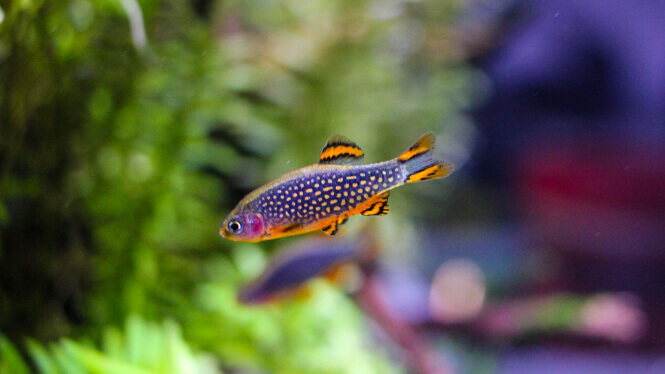
By amanofscience
| Compatible With: | Smaller cold-water bottom-feeders such as the Bristlenose or the Rubber-lip Pleco, adult Cherry Shrimp (may try to eat juveniles), Hillstream and Dojo Loaches, Zebra danios, white-cloud Mountain Minnows, American Flagfish |
| Size: | 1 inch (2.5 cm) |
| Suggested Water Temperature: | 71°F – 78°F (21.6°C – 25.5°C) |
| Suggested Tank Size: | 10 gallons, but go for 20+ for a community tank |
Celestial Pearl Danio, which belong to the Danio genus, is another great option for a community aquarium because they have a peaceful temperament and are so tiny they won’t take much of the tank’s space.
However, whatever it lacks in its size nature has generously compensated in looks because these fish have an impressive coloration pattern.
Learn more about the smallest nano fish for home aquariums.
The males are especially noticeable by their bright colors, but make sure you have both sexes in your community tank so that the males are not stressed.
The fish are active and enjoy swimming along, so much in an aquarium adorned with rocks, around which they shoal.
Celestial Pearl Danios do best as schooling nano fish in an unheated community tank because they prefer colder waters.
16. Corydora Sterbai – Corydoras sterbai
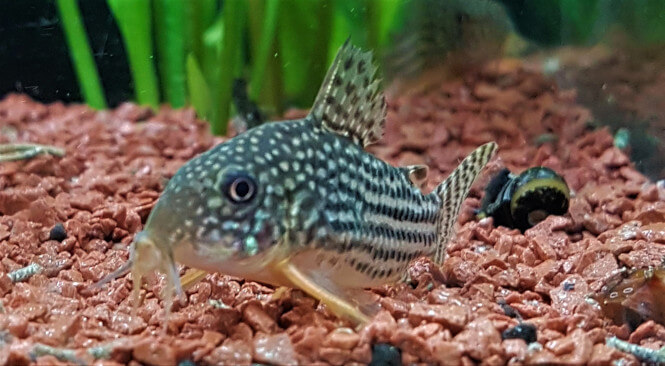
By GrandOverJoyed
| Compatible With: | Anabantoids, Cyprinids, Small Characins, other peaceful Catfish, bottom and top-dwelling peaceful fish of similar size, etc. |
| Size: | 2.7 inches or around 6.8 cm |
| Suggested Water Temperature: | 72°F – 79°F (22°C – 26.1°C) |
| Suggested Tank Size: | 20 gallons as a minimum, but preferably 40+ |
Should you need tropical bottom feeders in a freshwater community tank, go for Corydoras Sterbai.
They are one of the over 185 known Cory species from the genus known as Corydoras.
These days it is hard to get them in the wild (and you should not try!).
In fact, the ones you buy at the fish stores have been farm-bred for commercial purposes.
Here is how Sterbai cories fit a community fish:
Corydora Sterbai are among the best and most peaceful bottom feeder fish for a tropical community aquarium because they help in clearing the food leftovers and do not bother other fish while doing so.
Feed Sterbai cories with sinking food (flake, micro pellet, worms).
These fish are lovely in appearance due to the white marks that decorate their dark head and parts of the body.
They are also good-natured, making them strong candidates for a community tank.
Sterbai cories socialize easily with the other tank-makes provided they are also friendly.
It would be best if you keep them in a school of not less than 6 specimens to boost their confidence.
17. Neon Blue Rasbora – Sundadanio axelrodi
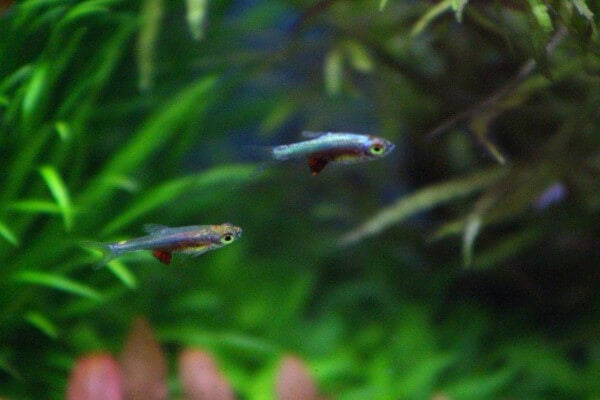
By KoopaTroopaz
| Compatible With: | other small-sized, peaceful fish |
| Size: | 0.74 inches or 1.88 cm |
| Suggested Water Temperature: | 72 – 78°F (22 – 25.5°C) |
| Suggested Tank Size: | 5 gallons for a dozen specimens |
Although tiny, the Neon Blue Rasbora has a stunning look and makes an impression in most aquarium keepers.
It is one of the four neon varieties: clear copper, copper, neon blue, and neon green.
These micro fish from the Sundadanio genus all glow like a speck of neon light when swimming.
The Neon Blue Rasbora is an excellent nano schooling fish for a freshwater community aquarium.
Here is why they are one of the best tiny community fish:
The Neon Blue Rasbora is one of the best small community fish for a peaceful nano tank because apart from being tiny, they are also very active and remain friendly to other aquarium mates.
They enjoy being in a planted community tank with enough space for shoaling and hiding.
A sandy substrate is a plus in such setups.
The other tank-mates should not be aggressive or large enough to eat them.
Neon Blue Rasboras are omnivores and enjoy frozen or live foods.
You can offer from bloodworms, and micro pellets to tubifex, though at times they might get quite choosy.
Related: Top Fish and Invertebrates for Stocking a 5-gallon Aquarium
18. Zebra Danio – Danio rerio
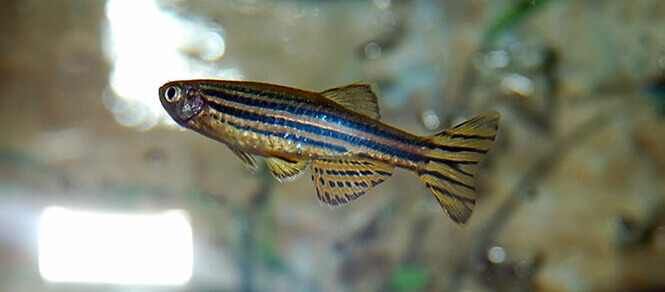
By dancerhas
| Compatible With: | White Cloud Mountain Minnows, Celestial Pearl Danios, Platys, Cory Catfish, Guppies, Small Barbs, Honey Gourami, Rubber Lip Plecos, Bristlenose Plecos, Hillstream loaches, American flagfish, Black-skirt tetras and other fish that would tolerate sub-tropical water temperatures |
| Size: | 2.2 inches (5.6 cm), but once in a while some may reach 2.5 (6.3 cm) |
| Suggested Water Temperature: | 64°F to 76°F (17°C to 25°C) |
| Suggested Tank Size: | 20 gallons for a school of 7 – 8 specimens |
Same as the Celestial Pearl Danio, the Zebra Danio are members of the Danio genus.
Zebra Danios are coldwater schooling fish suitable for a freshwater community aquarium and are friendly to the point they let other tank-mates join them in shoaling.
This alone qualifies them for a community fish tank, but there is more: they are pretty and stand out with their stripes that make them resemble a zebra.
Because of their temperature preference, Zebra Danios are one of the best community fish that do not need an aquarium heater.
They love schooling peacefully at the tank’s top, unbothered by the stronger water currents.
They may then harass other tank-mates, more as a preemptive defense mechanism than anything else.
So keep at least 7 specimens in your sub-tropical community fish tank. The Zebra Danio is a beginner-friendly fish and is one of the easiest ones to take care of in a home aquarium.
19. Rubber Lipped Pleco – Chaetostoma formosae
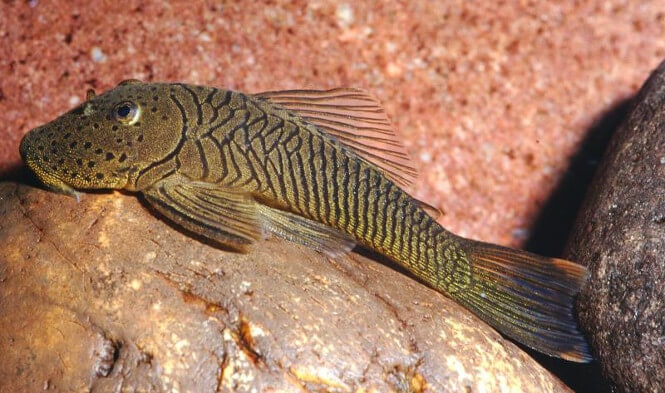
By Mark Smith
| Compatible With: | Swordtails, Tetras, Endlers, Gouramis, Danios, Barbs, Mollies, Platies, Goldfish |
| Size: | up to 4.2 inches (10.6 cm) |
| Suggested Water Temperature: | 71 to 78°F (21.5 to 25.5°C) |
| Suggested Tank Size: | 20 gallons long for a single Rubber lip pleco |
The Rubber-Lipped Pleco, one of the species among the Chaetostoma genus, is a good-natured fish that disturbs none of its tank-mates.
It is a pity that Rubber Lipped Pleco is not popular enough with fish stores in spite of the benefits it brings to an aquarium.
In fact, the rubber lip pleco is the best algae eater for an unheated freshwater tank with other peaceful community fish species.
Of course, this doesn’t imply that all they want to eat is algae.
If you choose to keep Rubber Lipped plecos as your bottom-feeding community fish, you’ll do them a great favor if you make sure all foods you feed them will sink to the bottom of the tank.
Rubber Lipped Pleco likely is the best algae eater for a sub-tropical, community fish tank. That’s because although it’s one of the few plecos that stay small in body size, it sure has an enormous appetite for the algae.
A full-grown Rubber Lip Pleco would get to about 4.5 inches of body length. As a committed algae-eater, its presence in a fish tank is an assurance that the algae growth is going to be kept under control. To learn more about this unpopular gem of a fish you can check my guide on the Rubber Lipped Pleco and how to take care of one.
20. Swordtails – Xiphophorus hellerii
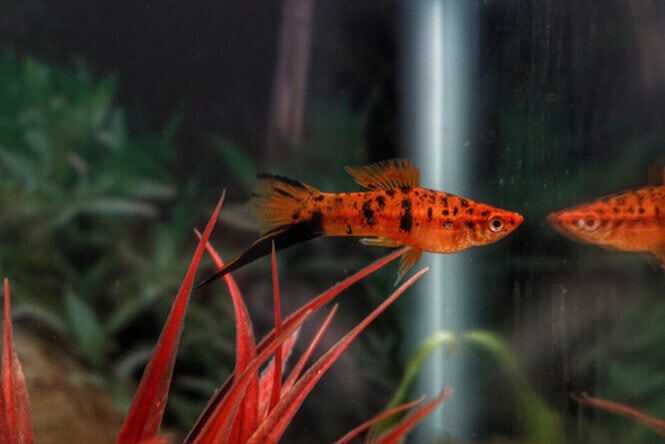
By cait_lonergan
| Compatible With: | Platies, Angelfish, Pearl Gouramis, schooling Tetra species, Non-Fancytail Guppies, tropical Corydoras, a school of Tiger Barbs, and Mollies |
| Size: | 4.2 inches or 10.6 cm including the outcrop tail |
| Suggested Water Temperature: | between 71°F and 77°F (21 to 25°С) |
| Suggested Tank Size: | 20+ gallons as the bare minimum |
These live-bearing fish are a part of the Xiphophorus genus.
The lower ends of their tails are sword-like, thus the name.
The swordtails are another bunch that do not school but still enjoy sticking together as a group.
They are peaceful, timid, and friendly to other tank-mates so they readily qualify for a community tank.
I have observed this, specifically among the males.
It’s something totally out of their character, but it can happen.
I believe you can diminish this aggression by providing each with at least two females.
Swordtails are also survivors who can tolerate harsh conditions that might otherwise kill certain fish species, which makes caring for them really easy.
Their hardiness is partly helped by the fact that the swordtails are omnivores, so they are not dependent on a particular food variety.
With that being said, make sure you take proper care of those cuties.
The fact that they’re hardy doesn’t mean they don’t deserve a happy life, which would be impossible if you neglect them.
21. Red Wagtail Platy – Xiphophorus maculatus
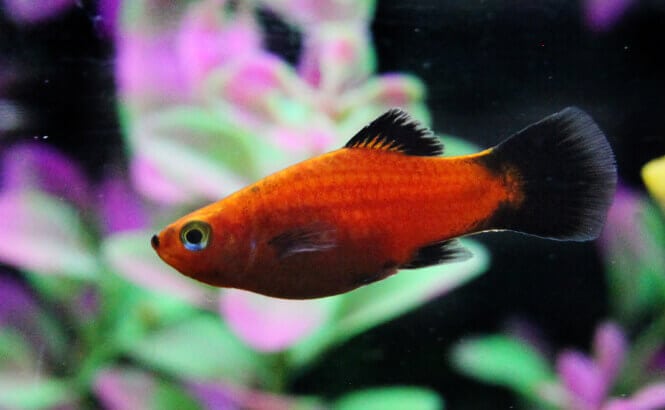
By Marrabbio2
| Compatible With: | Corydoras Catfish, Tetras, Guppies, Angels, Harlequin rasboras, Pearl Gourami, Honey Gourami, peaceful bottom dwellers and others |
| Size: | 2 inches (5 cm) |
| Suggested Water Temperature: | 73°F – 77°F (22.7°C – 25°C) |
| Suggested Tank Size: | 10+ gallons |
The Red Wagtail Platy is a tropical freshwater aquarium fish suitable for beginners because it is very easy to care for, hardy and beautiful. Red Wagtail platies are also in the league of the best tropical community fish, thanks to their rather peaceful nature towards other tank mates.
Like their Swordtail relatives, the Red Wagtail Platies are members of the same Xiphophorus genus.
What’s more, they are tiny and are not going to take much space in the aquarium.
While they enjoy chilling in groups, they are not strictly schooling fish.
It’s fun watching them display their vibrant coloration.
They get over-excited when happy and may jump out of the water, so it helps if a lid is placed over the tank, just in case.
Moreover, make sure there is no other opening they can use, for they are known to actively look for “loopholes” whenever they are inspired to jump.
With every other thing in place, you’ll realize they are indeed the easiest freshwater community fish to take care of.
22. Umbrella Cichlid – Apistogramma borellii
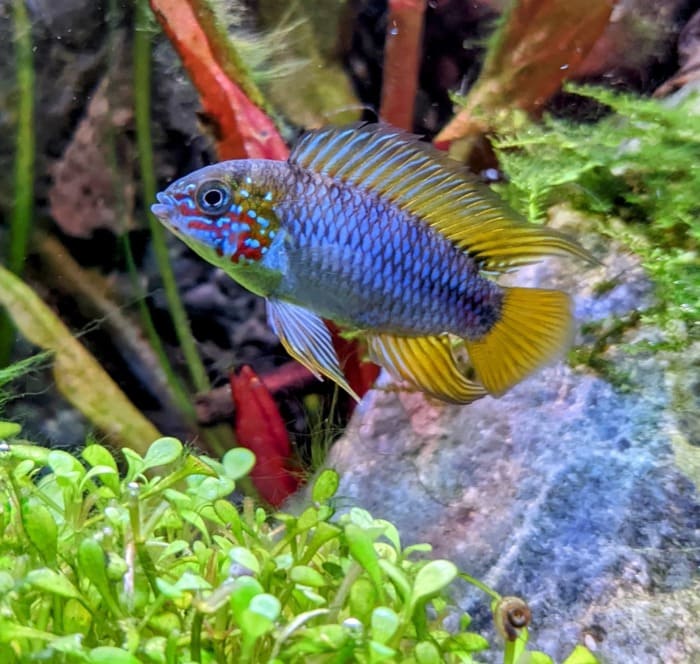
by mimimimimi2
| Compatible With: | Tetras, Corydoras, Plecos, and other equally sized and peaceful fish |
| Size: | 2.6 inches (6.5 cm) |
| Suggested Water Temperature: | 74 – 84°F (23 – 29°C) |
| Suggested Tank Size: | 20 gallons |
The Umbrella cichlid from the Apistogramma genus is one of the few peaceful fish of its kind.
Unlike other cichlids who tend to be highly aggressive, this dwarf generally gets along with most other species.
The most notable species you should avoid housing them with are Angelfish.
Even though it’s possible to keep these two fish together, there’s a high chance the Angelfish will harass the otherwise peaceful Umbrella cichlid.
In the wild, Umbrella cichlids feed on bottom dwelling invertebrates, so you might often find them foraging the substrate for food.
As a result of their carnivorous nature, they should be fed with bloodworms, daphnia, or brine shrimp.
Apart from their peaceful character, Umbrella cichlids are also exceptionally hardy.
These two traits make them an excellent community fish for beginners.
Author’s note: Umbrella cichlids can survive temperature drops down to 40°F. Due to this, they are often used in small outdoor ponds.
23. Glass Catfish – Kryptopterus vitreolus
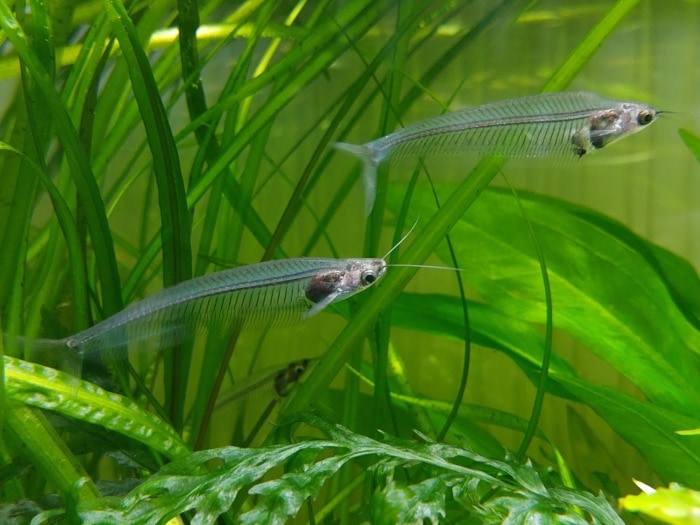
by John q
| Compatible With: | Mollies, Swordtails, Guppies, Tetras |
| Size: | 3.1 inches (7.8 cm) |
| Suggested Water Temperature: | 74 – 79°F (23.3 – 26.1°C) |
| Suggested Tank Size: | 30 gallons |
Glass Catfish (Kryptopterus vitreolus) are anything but your typical catfish species.
They have slender bodies, swim in schools and have no time for playing around at the bottom of the aquarium.
However, the single trait that distinguishes them from other catfish species is their see-through body.
Since it doesn’t have any pigmentation, light freely passes through it and makes glass catfish seem transparent.
Apart from giving them an aesthetic appearance, this also increases their survival odds in the wild.
Under low light conditions, glass catfish become practically invisible, so they often get passed by predatory fish.
Their survivability in the aquarium, however, isn’t as robust.
Author’s note: The whiskers of glass catfish help them sense changes in the environment by detecting electromagnetic waves. Due to this, scientists are now studying glass catfish in hopes of finding a better understanding of Parkinson’s disease.
Glass catfish are extremely sensitive to changes in the water parameters so they can easily get stressed if you’re not careful.
This is why I don’t recommend them to beginners.
With that being said, these transparent fish are quite amicable once they overcome their initial shyness.
You won’t have any trouble keeping them in a community, as long as the other members are peaceful.
24. White Cloud Mountain Minnow – Tanichthys albonubes
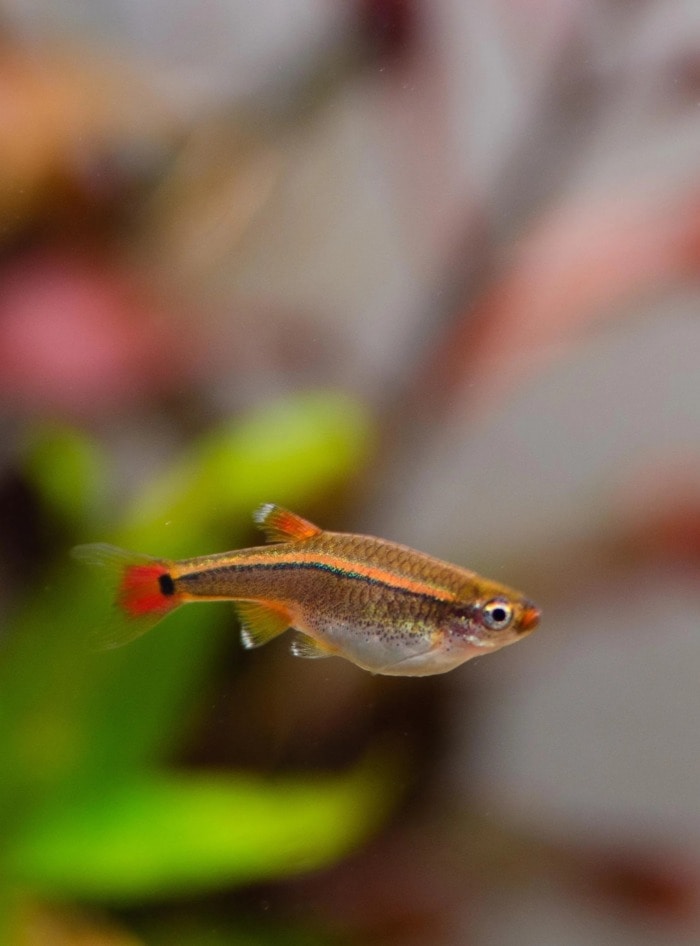
by computerboi85
| Compatible With: | Guppies, Zebra Danios, Endler’s Livebearers, Corydoras, Celestial Pearl Danio |
| Size: | 1.4 inches (3.6 cm) |
| Suggested Water Temperature: | 59 to 71°F (15 to 22°C) |
| Suggested Tank Size: | 10 gallons |
For a long time, white cloud mountain minnows were the only members of the Tanichthys genus.
In 2001, however, scientists discovered two other species that shared common features with them.
Presently, however, only one of these species, the Tanichthys micagemmae, is commercially available.
Apart from their relative uniqueness, white cloud mountain minnows have a somewhat plain appearance.
They have a shimmering bronze coat, with a red line running from their tail to their eyes.
Males are slightly larger and have a more colorful appearance.
In terms of behavior, white cloud mountain minnows are quite calm so they’re an excellent choice for community setups.
It should be noted, however, that they should be kept in schools of at least six fish.
If you keep them alone, they’ll start to lose their color and might get sick.
What to Pick For a Good Centerpiece Fish?
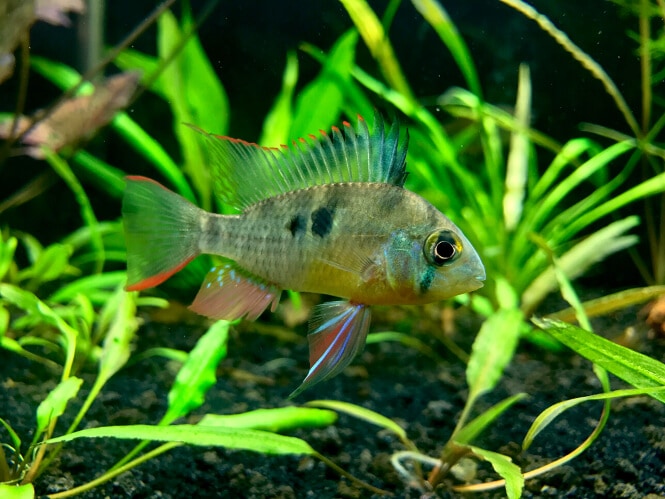
By manuallaborsucks
From this list, here are some of the best peaceful centerpiece fish for a freshwater aquarium:
The Bolivian Ram is a perfect choice for a freshwater centerpiece fish. Its beauty stands out while its personality is friendly and easy-going towards other tank mates. They come in many attractive colors that make them stand out in a community tank. Another fish that qualifies for a tropical freshwater aquarium is Keyhole Cichlid due to its unusually peaceful personality.
Its large size and odd coloration make it stand out from the group.
What to Get if You’re Still a Beginner in Freshwater Aquarium Keeping?
If you are just starting, consider these hardy community freshwater fish that are great for beginners:
The Red Wagtail Platy is one hardy fish that tolerates harsh environments and is also non-demanding in terms of care, making it a good choice for a beginner hobbyist. Then there is the Zebra Danios, which are also hardy, on top of thriving in sub-tropical water conditions.
The beginners who want to start with a community freshwater tank should seriously consider these fish.
They are not easily affected by water temperature fluctuations, which are some of the teething problems new hobbyists struggle with.
My Final Thoughts
So that’s the long and the short of it.
Hopefully, you are now in a better position to populate your freshwater aquarium with the right community fish, be they tropical or not.
Furthermore, you should also be able to choose a fish that would best fit the community as a centerpiece in the tank.
Leave me a comment below if you need more answers.
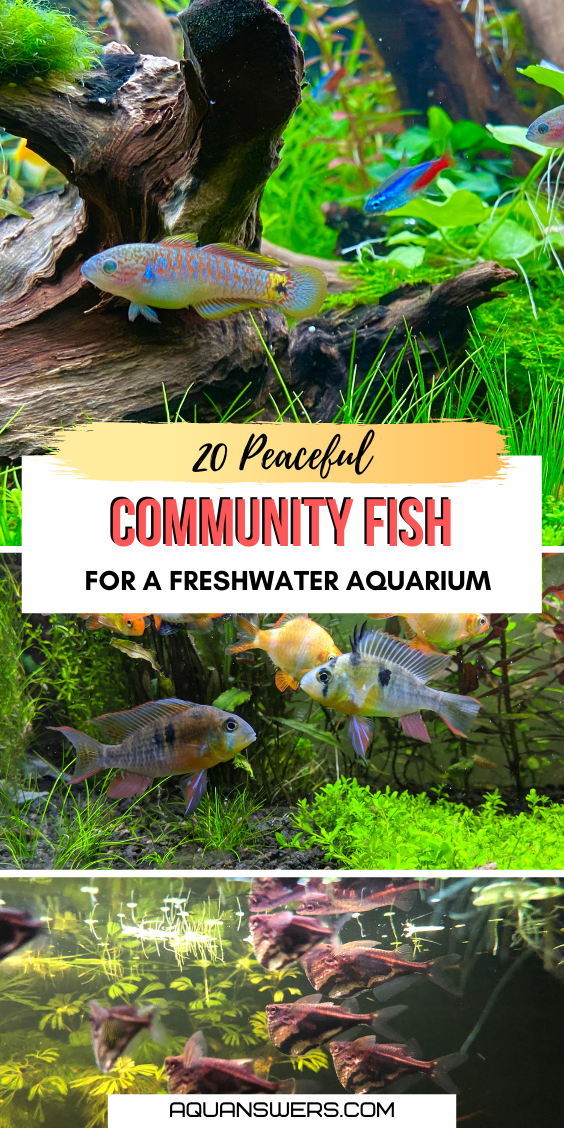

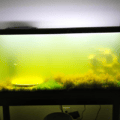
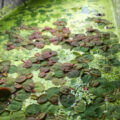
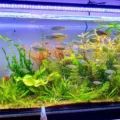
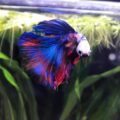


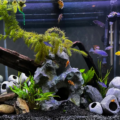
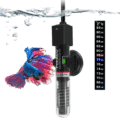
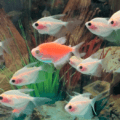
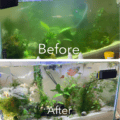
25 thoughts on “The 24 Best Community Fish for a Social Freshwater Aquarium”